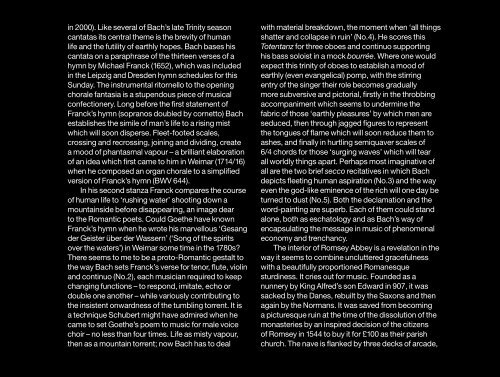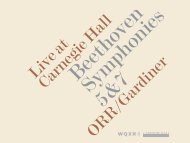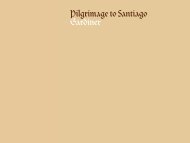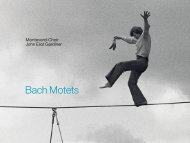Download CD booklet - Monteverdi Choir
Download CD booklet - Monteverdi Choir
Download CD booklet - Monteverdi Choir
Sie wollen auch ein ePaper? Erhöhen Sie die Reichweite Ihrer Titel.
YUMPU macht aus Druck-PDFs automatisch weboptimierte ePaper, die Google liebt.
in 2000). Like several of Bach’s late Trinity season<br />
cantatas its central theme is the brevity of human<br />
life and the futility of earthly hopes. Bach bases his<br />
cantata on a paraphrase of the thirteen verses of a<br />
hymn by Michael Franck (1652), which was included<br />
in the Leipzig and Dresden hymn schedules for this<br />
Sunday. The instrumental ritornello to the opening<br />
chorale fantasia is a stupendous piece of musical<br />
confectionery. Long before the first statement of<br />
Franck’s hymn (sopranos doubled by cornetto) Bach<br />
establishes the simile of man’s life to a rising mist<br />
which will soon disperse. Fleet-footed scales,<br />
crossing and recrossing, joining and dividing, create<br />
a mood of phantasmal vapour – a brilliant elaboration<br />
of an idea which first came to him in Weimar (1714/16)<br />
when he composed an organ chorale to a simplified<br />
version of Franck’s hymn (BWV 644).<br />
In his second stanza Franck compares the course<br />
of human life to ‘rushing water’ shooting down a<br />
mountainside before disappearing, an image dear<br />
to the Romantic poets. Could Goethe have known<br />
Franck’s hymn when he wrote his marvellous ‘Gesang<br />
der Geister über der Wassern’ (‘Song of the spirits<br />
over the waters’) in Weimar some time in the 1780s?<br />
There seems to me to be a proto-Romantic gestalt to<br />
the way Bach sets Franck’s verse for tenor, flute, violin<br />
and continuo (No.2), each musician required to keep<br />
changing functions – to respond, imitate, echo or<br />
double one another – while variously contributing to<br />
the insistent onwardness of the tumbling torrent. It is<br />
a technique Schubert might have admired when he<br />
came to set Goethe’s poem to music for male voice<br />
choir – no less than four times. Life as misty vapour,<br />
then as a mountain torrent; now Bach has to deal<br />
with material breakdown, the moment when ‘all things<br />
shatter and collapse in ruin’ (No.4). He scores this<br />
Totentanz for three oboes and continuo supporting<br />
his bass soloist in a mock bourrée. Where one would<br />
expect this trinity of oboes to establish a mood of<br />
earthly (even evangelical) pomp, with the stirring<br />
entry of the singer their role becomes gradually<br />
more subversive and pictorial, firstly in the throbbing<br />
accompaniment which seems to undermine the<br />
fabric of those ‘earthly pleasures’ by which men are<br />
seduced, then through jagged figures to represent<br />
the tongues of flame which will soon reduce them to<br />
ashes, and finally in hurtling semiquaver scales of<br />
6/4 chords for those ‘surging waves’ which will tear<br />
all worldly things apart. Perhaps most imaginative of<br />
all are the two brief secco recitatives in which Bach<br />
depicts fleeting human aspiration (No.3) and the way<br />
even the god-like eminence of the rich will one day be<br />
turned to dust (No.5). Both the declamation and the<br />
word-painting are superb. Each of them could stand<br />
alone, both as eschatology and as Bach’s way of<br />
encapsulating the message in music of phenomenal<br />
economy and trenchancy.<br />
The interior of Romsey Abbey is a revelation in the<br />
way it seems to combine uncluttered gracefulness<br />
with a beautifully proportioned Romanesque<br />
sturdiness. It cries out for music. Founded as a<br />
nunnery by King Alfred’s son Edward in 907, it was<br />
sacked by the Danes, rebuilt by the Saxons and then<br />
again by the Normans. It was saved from becoming<br />
a picturesque ruin at the time of the dissolution of the<br />
monasteries by an inspired decision of the citizens<br />
of Romsey in 1544 to buy it for £100 as their parish<br />
church. The nave is flanked by three decks of arcade,<br />
15






